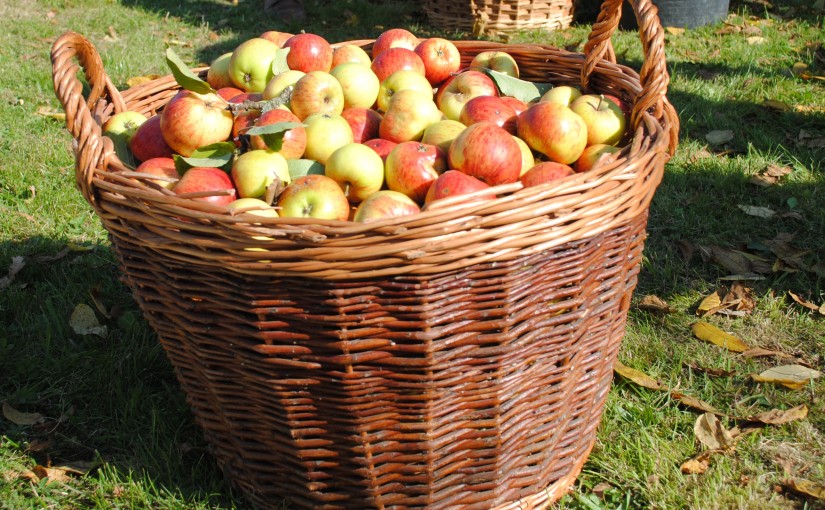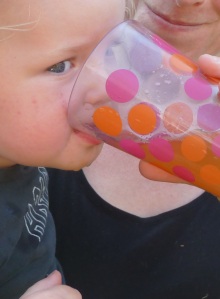
Apple Delight
We are fortunate enough to have a good size apple orchard that has been generously producing tons of apples for us year after year. Some years we have a massive crop some years we have a much smaller crop, like this year for example. We share the crop with a lot of wildlife, in particular with birds. Every autumn a big flock of migrating redwings and fieldfares are stopping in our orchard to gorge on apple windfalls.
Three or four years ago, the idea of hosting an annual apple fest was born. We wanted to share the joy of picking apples and making apple juice/cider/vinegar with our families and friends. It is also a great reason for merriment with people we love, old friends and new friends, to enjoy the delight of community gathering working together and mucking in to turn apples into yummy fresh, natural juice. An important part was to get children to see where apples come from; therefore, we encourage and support kids to be hands on in all stages of apple juice making. The apple juice we make is only for our own consumption, we don’t do this commercially.
This year, as our crop was minuscule, we teamed up with one of our neighbours, who picked his apples and brought them over for juicing. Between us we made over 100l of apple juice. Throughout the years many of our friends and family helped with the juice making and lots of people asked about the process. So, in this blog I will share with you how we make our juice, what do you need and what’s the process. If you have any questions, I’d be delighted to answer them.
In the past we made anything from about 300l to as little as 100l. You might not have that many apples but you can always team up with your neighbours, who may have some apples too, and share the resulting juice. Many hands make easy work, the more the merrier and all that. Besides, after you finished it’s lovely to share some food and sample the freshly squeezed juice together plus a bottle of beer or two, if you prefer.
We are pretty laid back about it, however, there is a serious amount of work that needs to happen so a good start is to enlist a number of people that are available on that day and willing to muck in. Bribe them if you have to with good food and a bonfire! That always worked for us! In our first year, we invited the local ceilidh band so we had some dancing till late at night in our barns. That year about 30 people came to help. We made something like 150 litres of juice, great fun was had (and a twisted ankle!) and that really inspired us to keep on bringing it back every year.
We found that doing some preparation in advance makes the day run smoother and stress free. So I’ll start with a list of things we prepare in advance:
- We send out an invite to all our friends. We ask them to bring friends, sleeping bags (if they come from further afield), towels, torches, food and drinks to share, Wellingtons, all weather clothes, clean bottles to take home fresh apple juice in, bags to take apples home, musical instruments to play by the fire. We ask them to RSVP, so we can get a rough idea how many people will be coming so we can organise ourselves accordingly. We can accommodate people over night but to make it easier for us, we don’t provide bedding (no need to wash 20 bed sets used only one night!).
- We wash 200 apple juice bottles and 30 plastic, milk or soda bottles. We got our bottles four years ago from a friend who has an apple juice making business and had some lying about that needed washing (as he explained it’s not economically viable for them to wash them, they just buy new ones every year!). We use the plastic bottles for juice that people can take home and will use straight away as you can’t pasteurise them in plastic bottles but they can be frozen and will last for a couple of months once frozen.
- We gather tables, funnels, clean tubs, clean buckets, truggs, etc to be set up in the orchard.
- We pick up scratter and apple press on Friday or Saturday morning; they can also provide a pasteurising machine, which we didn’t realise until this year when we returned the equipment! We now booked that too for next year and that will mean a big chunk of work out of the way as pasteurising on the hob is a very time consuming operation. We get our scratter and press on loan every autumn from the local Apple Orchards Association, who for a small amount will lend them to us. We need to book well in advance, as demand is big at this time of the year.
- We buy bottle tops – you can buy these from most farm shops.
- We prepare the bonfire and the wood for fire – it’s lovely after a good days work to light a bonfire and chill around the fire. If it rains we need to cover bonfire with tarpaulin 2-3 days in advance. We are in the UK so rain is an everyday possibility! So far we were extremely lucky and we had glorious sunshine each year for the apple fest!
- We mow the orchard so the grass doesn’t get trampled and clear access to kitchen.
- We clear our big barns and set up gazebos, in case it rains.
- We start saving milk bottles (aprox 30, 1l and 2l), we wash and store them in a clean space.
- We make a list of guests staying the night and allocate sleeping spaces.
- There are various items we take up to the barns: milk, butter, cereals, tea/coffee, bread, gem, honey, eggs, oil, etc handy for the break. We prepare some bread and soup in advance for lunch; it’s difficult to cook on the day with everybody busy picking and juicing apples. Pasta goes down well for children. We also prepare a couple of spanish tortillas, 2-3 salads, 3-4 cakes, pot of chilli or smth similar for diner. It all depends on the size of the gang we are expecting. For lunch, we feed everybody and we do a potluck dinner, where we can all share some food and drinks.
- We buy beer and wine to share.
- We buy Milton, 3 bottles at 500 ml each (from Boots) and 200 g vitamin C powder from the local wholefood shop. We use the Milton to sterilise the bottles and the vitamin C for stopping the fresh juice to oxidise hence turn into a dark brown juice as opposed to golden.
- We buy a couple of new truggs, 10l food tall plastic container (will need about 3 on the day), 2 bottle brushes, 3 funnels. We realised that during the day things get broken so we need a couple of new items each year ready to replace the old one if they break on the day, and break they will!
Here’s a list of the equipment needed:
1 scratter to pulp the fruit
1 apple press to squeeze the juice out
electricity, extension cable
water, a hose and a couple of big plastic tubs for washing apples
3 tables, 3 gardening truggs, 2l plastic or metal jugs X 3, a couple of bottle brushes, 10l plastic tall containers X3, 3-4 funnels
2 clean tarpaulins
bottles and bottle tops
5 big pans with boiling water for pasteurising on the hob
2 step ladders, canes to reach tall branches
2-3 wheelbarrows
10 buckets
some clean sheets, dishcloth and kitchen towels.
In my next blog I will tell you how exactly we do the juicing. Until then thanks for reading 🙂

